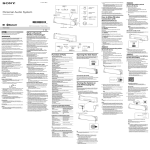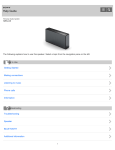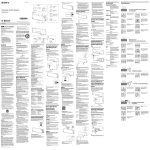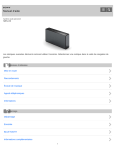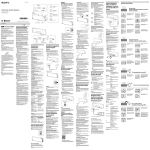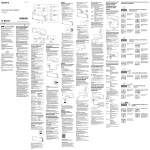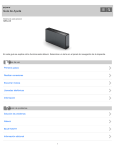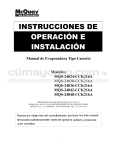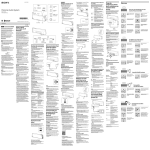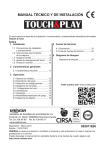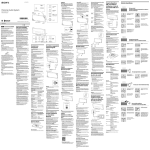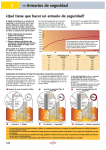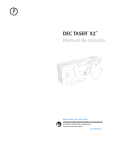Download Manual de instrucciones
Transcript
3 Press and hold the BLUETOOTH-PAIRING 4-449-952-61(1) button on the system until two beeps are heard. The Bluetooth indicator (blue) begins to flash quickly and pairing mode is entered. VOLUME −/+ buttons SOUND button/ indicator Personal Audio System LOCK RELEASE switch (call) button Operating Instructions Manual de instrucciones Tip When the system is turned on first time, the Bluetooth indicator (blue) starts flashing quickly. AUDIO IN button/ indicator BATTERY/CHARGE indicator N-mark If it is difficult to establish the connection, try the following. – Activate the app “NFC Easy Connect” and move the smartphone slightly on the N marked part of the system. – If the smartphone is in a case, remove it. Touch the system with the smartphone again to disconnect. If you have multiple NFC compatible devices, just touch the smartphone to a different device to switch the connection to that device. For example, when your smartphone is connected with NFC compatible headphones, just touch the smartphone to the system to change the Bluetooth connection to the system (One touch connection switching). Flashes quickly the Bluetooth device. Personal Audio System Before operating the system, please read this guide thoroughly and retain it for future reference. To reduce the risk of fire, do not cover the ventilation of the apparatus with newspapers, tablecloths, curtains, etc. And do not place lighted candles on the apparatus. To reduce the risk of fire or electric shock, do not expose this apparatus to dripping or splashing, and do not place objects filled with liquids, such as vases, on the apparatus. Do not install the appliance in a confined space, such as a bookcase or built-in cabinet. Do not expose the batteries (battery pack or batteries installed) to excessive heat such as sunshine, fire or the like for a long time. As the main plug of AC adaptor is used to disconnect the AC adaptor from the mains, connect it to an easily accessible AC outlet. Should you notice an abnormality in it, disconnect it from the AC outlet immediately. The unit is not disconnected from the AC power source (mains) as long as it is connected to the wall outlet, even if the unit itself has been turned off. The nameplate and important information concerning safety are located on the bottom exterior of the main unit and on the surface of the AC adaptor. CAUTION Danger of explosion if battery is incorrectly replaced. Replace only with the same or equivalent type. On Copyrights and Licenses The Bluetooth® word mark and logos are owned by the Bluetooth SIG, Inc. and any use of such marks by Sony Corporation is under license. The N Mark is a trademark or registered trademark of NFC Forum, Inc. in the United States and in other countries. Android is a trademark of Google Inc. iPhone is a trademark of Apple Inc., registered in the U.S. and other countries. The “aptX® software is copyright CSR plc or its group companies. All rights reserved. The aptX® mark and the aptX logo are trade marks of CSR plc or one of its group companies and may be registered in one or more jurisdictions.” Other trademarks and trade names are those of their respective owners. Precautions Notes when using with a mobile phone For details on operation of your mobile phone when receiving a telephone call while transmitting the sound using the Bluetooth connection, refer to the operating instructions supplied with the mobile phone. On safety Notes on the AC adaptor When connecting or disconnecting the AC adaptor, turn off the system beforehand. Otherwise, it may cause malfunction. Use only the supplied AC adaptor. To avoid damaging the system, do not use any other AC adaptor. Polarity of the plug Plug the AC adaptor into a nearby wall outlet (mains). In the case of a problem, unplug it from the wall outlet (mains) immediately. Do not install the AC adaptor in a confined space, such as a bookcase or built-in cabinet. To reduce the risk of fire or electric shock, do not expose the AC adaptor to dripping or splashing, and do not place objects filled with liquids, such as vases, on the AC adaptor. On placement Do not set the speaker in an inclined position. Do not leave the system in a location near heat sources, or in a place subject to direct sunlight, excessive dust, moisture, rain or mechanical shock. On operation Do not insert any small objects, etc., into the jacks or ventilation hole on the rear of the system. The system may short out or malfunction. On cleaning Do not use alcohol, benzine, or thinner to clean the cabinet. Others If you have any questions or problems concerning this system that are not covered in this manual, please consult your nearest Sony dealer. If “SRS- BTX300” does not appear on the device’s display, repeat from step 2. What is Bluetooth Wireless Technology? Note Some devices cannot display a list of detected devices. 6 If Passcode* input is required on the display Bluetooth wireless technology is a short-range wireless technology that enables wireless data communication between digital devices, such as a computer and digital camera. Bluetooth wireless technology operates within a range of about 10 m. Connecting two devices as necessary is common, but some devices can be connected to multiple devices at the same time. You do not need to use a cable for connection, nor is it necessary for the devices to face one another, such is the case with infrared technology. For example, you can use such a device in a bag or pocket. Bluetooth standard is an international standard supported by thousands of companies all over the world, and employed by various companies worldwide. of the Bluetooth device, input “0000.” The Bluetooth connection is established and the Bluetooth indicator (blue) on the system stays on. * Passcode may be called “Passkey,” “PIN code,” “PIN number,” or “Password.” Tip Communication system and compatible Bluetooth profiles of the system Profile is standardisation of the function for each Bluetooth device specification. The system supports the following Bluetooth version and profiles: Communication System: Bluetooth Specification version 3.0 Compatible Bluetooth Profiles: – A2DP (Advanced Audio Distribution Profile): Transmitting or receiving audio content of high-quality. – AVRCP (Audio Video Remote Control Profile): Controlling the volume. – HSP (Headset Profile): Talking on the phone/Operating the phone. – HFP (Hands-free Profile): Talking on the phone/Operating the phone by hands-free. Maximum communication range Use Bluetooth devices within 10 m (line of sight) of the system. Maximum communication range may shorten under the following conditions. – There is an obstacle such as a person, metal, or wall between the system and Bluetooth device. – A wireless LAN device is in use near the system. – A microwave oven is in use near the system. – A device that generates electromagnetic radiation is in use near the system. Interference from other devices Because Bluetooth devices and wireless LAN (IEEE802.11b/g) use the same frequency, microwave interference may occur and resulting in communication speed deterioration, noise, or invalid connection if the system is used near a wireless LAN device. In such a case, perform the following. – Use the system at least 10 m away from the wireless LAN device. – If the system is used within 10 m of a wireless LAN device, turn off the wireless LAN device. BLUETOOTH STANDBY switch DC IN12.5V jack Function of Parts BATTERY/CHARGE indicator Lights up, flashes or turns off depending on the status of the system. For details, see the following section, “Indications of BATTERY/ CHARGE indicator.” N-mark Touch to make Bluetooth connection with an NFC compatible smartphone. (call) button Press to call or operate during a call. Turning the System on and off/Charging the system Pairing mode of the system is cancelled after about 5 minutes, and the Bluetooth indicator (blue) flashes. If the pairing mode is cancelled while performing this procedure, start over from step 3. Passcode of the system is fixed as “0000.” The system cannot be paired with a Bluetooth device whose Passcode is not “0000.” Once Bluetooth devices are paired, there is no need to pair those devices again. However, in the following case, you will need to perform the pairing procedure again. – The system is paired with 9 or more devices. The system can be paired with up to 8 Bluetooth devices. If a new device is paired after 8 devices have been paired, the device whose latest connection time is the oldest among the 8 paired devices is replaced by the new one. More than one device can be paired with the system, but sound will be heard from just one of those devices. Pattern B This system can operate by AC adaptor or built-in lithium-ion battery (rechargeable). Charge the battery before using the system for the first time. Connecting with a paired Bluetooth device 1 Connect the supplied AC adaptor. 1 Turn on the system. The BATTERY/CHARGE indicator (amber) lights up when the battery is being charged, and turns off when charging is complete. It takes approximately 4 hours to charge the battery. LOCK RELEASE switch Use for opening and closing the side stand. The Bluetooth indicator (blue) flashes. If the AUDIO IN indicator (amber) lights up, press the BLUETOOTH-PAIRING button. effect. Operations may vary depending on the Bluetooth device. Refer also to the operating instructions supplied with your Bluetooth device. The SOUND indicator (see below) shows the current sound effect setting. You can switch between effects by repeatedly pressing the SOUND button. 1 Make the Bluetooth connection between the system and the device. For details on the Bluetooth connection procedure, see “How to Make Wireless Connection with Bluetooth Devices.” When the Bluetooth connection is established, the Bluetooth indicator (blue) on the system stays on. 2 Start playback on the Bluetooth device, then adjust the volume. Set the volume of the Bluetooth device to a moderate level, and press the VOLUME –/+ buttons on the system. Auto power off The system automatically turns off after about 20 minutes when the hands-free is not being used (the system is not connected with a Bluetooth device via HFP/HSP), and when no device is being charged via the DC OUT ONLY connector, and when no music is being played. After use Do any of the following. Set the Bluetooth function of the Bluetooth device off. For details, refer to the operating instructions supplied with the device. Turn off the Bluetooth device. Turn off the system. Touch the system with the smartphone again to disconnect (NFC compatible smartphones only). Using Hands-free Calling While Listening to Music Status Sound effect Amber High-quality bass sound will be heard (MEGA BASS). This setting is enabled by default when you first turn on the system. Green Surround sound will be heard (MEGA BASS+SURROUND). Off The sound effect is off. Tip The system remembers the last sound effect setting next time it is turned on. Listening to Music by Wired Connection with a Portable Audio Device, etc. 1 Connect the device to the system. You can enjoy hands-free calling via Bluetooth connection with a Bluetooth mobile phone that has a music function and supports the Bluetooth profile A2DP, and HFP or HSP. If your Bluetooth mobile phone supports both HFP and HSP, set to HFP. (Stereo mini jack) 2 Set the Bluetooth function of the Bluetooth device to on. Side stand Open to use the system. Tip In the case of the last-connected Bluetooth device, the system tries to re-establish Bluetooth connection with it if the device’s Bluetooth function is on. When Bluetooth connection is established, the Bluetooth indicator (blue) on the system stays on. Illumination lamp Lights up in a variety of colors depending on the status of the system. For details, see the following section, “Indications of Illumination lamp.” Connecting cord (not supplied) 3 Select “SRS-BTX300” shown in the display of Microphone Use during a call. the Bluetooth device. DC IN 12.5V jack Connects the supplied AC adaptor. Microwaves emitting from a Bluetooth device may affect the operation of electronic medical devices. Turn off the system and other Bluetooth devices in the following locations, as it may cause an accident. – where inflammable gas is present, in a hospital, train, airplane, or a gas station – near automatic doors or a fire alarm RESET button Resets the system. DC OUT ONLY connector (USB) Charges devices, such as your smartphone, etc. by connecting to the DC OUT ONLY connector (USB connector). Notes 2 Press the / button. This step may not be necessary for some devices. If the system cannot connect to the Bluetooth device, delete “SRS-BTX300” from the Bluetooth device, then perform pairing again. Bluetooth standby mode When the Bluetooth standby mode is set to ON, the system can be turned on and operated by a Bluetooth device. SOUND button Press to select a sound effect. SOUND indicator Lights up, according to the sound effect setting. Lights up (green) (battery operation only) Battery requires charging Flashes (green) Charging battery Lights up (amber) Charging complete Off Indications of Illumination lamp Status Illumination lamp AUDIO IN mode Lights up (white) Searching for a device Lights up (white) Connecting to Bluetooth device Lights up (blue) Pressing VOLUME−/+ buttons When the volume hits the maximum or minimum Flashes once (white) Flashes three times (white) To receive a call You can operate the system by battery instead of the AC adaptor by charging the system before use. Notes When the BATTERY/CHARGE indicator flashes as below, charge the system. In these cases, you cannot charge devices via the DC OUT ONLY connector. – Flashes (green) (Battery power is low). – Flashes (amber), then turns off after turning on the system (No battery power remaining). When you switch the power source between AC adaptor and battery by connecting/disconnecting the AC adaptor, the system stops sound output for a short while. This is not a malfunction. The maximum power output will be lower when the AC adaptor is disconnected. In an extremely cold or hot environment, note the following points. – When operating by the AC adaptor, charging may complete too quickly, or may not be possible. – When operating on battery only, the system may stop after the BATTERY/CHARGE indicator flashes (green) three times. Charge the battery at least twice a year. Repeated recharging causes the capacity of the battery to decrease over time. When the battery life drops to half the usual time, even after a full charge, contact your nearest Sony dealer to replace the battery. To reset the system Tip Press the RESET button on the rear of the system with a pointed object if the buttons on the system do not function. Indications of the Bluetooth function How to Make Wireless Connection with Bluetooth Devices To turn the illumination on/off, hold down the BLUETOOTH-PAIRING button, then press and hold the / button. Status Bluetooth indicator (blue) Pairing with a device Flashes quickly Searching for a device Flashes Connected to a device Lights up Bluetooth standby mode Flashes slowly Opening the Side Stand Open the side stand and operate the buttons inside. The side stand also functions as a support while using the system. Slide the LOCK RELEASE switch in the direction of the arrow (illustration) to open the side stand. The Bluetooth standby function will be turned off automatically when the side stand is closed. If the system is being powered by battery, even if the system is turned off, battery power will continue to be consumed if the BLUETOOTH STANDBY switch is set to ON. Pattern C Connecting with a smartphone by One touch (NFC) By just touching the system with an NFC compatible smartphone, the system is turned on automatically and then paired and connected with the smartphone. 1 Download and install the app “NFC Easy Connect” on the smartphone. “NFC Easy Connect” is an original app by Sony for Android phones, and is available at Google Play Store. Search for “NFC Easy Connect” or scan the following twodimensional code to download and install the free app. Communication fees are required to download the app. The app may not be downloadable in some country/ regions. Tip For some smartphones, One touch connection may be available without downloading the app “NFC Easy Connect.” In that case, the operation and specifications may be different from the description here. For details, refer to the operating instructions supplied with the smartphone. By the two-dimensional code: Use a two-dimensional code reader app. Compatible smartphones Smartphones with the NFC function built-in (OS: Android 2.3.3 or later, excluding Android 3.x) Pairing with a Bluetooth device: see Pattern A About NFC Bluetooth devices need to be “paired” with each other beforehand. To listen to music with a Bluetooth device that has been paired, see this pattern. One touch connection with a smartphone (NFC): see Pattern C Using an NFC compatible smartphone, you can establish a Bluetooth connection by just touching the system with it. Check the following before operating the system. Both the system and the device are placed within 1 m of each other. The system is connected to the AC adaptor, or the battery is sufficiently charged. The operating instructions supplied with the device are at hand. Close the side stand when you carry the system. Slide the LOCK RELEASE switch in the direction shown by the arrow above, then close the side stand by hand. The system automatically turns off when the side stand is closed. Notes You can enjoy music and hands-free calling with the system wirelessly by using your device’s Bluetooth function. Choose one of the following three connection methods, best suited for the Bluetooth device. For details on how to operate your device, refer to the operating instructions supplied with the device. Connecting with a paired device: see Pattern B To close the side stand For details on the Bluetooth connection procedure, see “How to Make Wireless Connection with Bluetooth Devices.” When the Bluetooth connection is established, the Bluetooth indicator (blue) on the system stays on. Operate the Bluetooth mobile phone. Check that a dialing tone is heard on the system and talk using the microphone. If no dialing tone is heard, press the (call) button on the system for about 2 seconds to change the call device to the system. Tip System turned on system and the mobile phone. To call Bluetooth indicator (blue) Lights up, flashes or turns off depending on the communication status. For details, see the following section, “Indications of the Bluetooth function.” BATTERY/CHARGE indicator 1 Make the Bluetooth connection between the Set the volume of the Bluetooth mobile phone to a moderate level, and press the VOLUME –/+ buttons on the system. BLUETOOTH-PAIRING button Press to pair with a Bluetooth device. Status 5 Operate the connected device. phone, then adjust the volume. AUDIO IN indicator (amber) Lights up in AUDIO IN mode. Indications of BATTERY/CHARGE indicator (built-in lithium-ion battery) 4 Press the AUDIO IN button on the system. 2 Start playback on the Bluetooth mobile AUDIO IN button Press to listen to sound from a device connected by a connecting cord (not supplied). / button Turns the system on/off. 3 Turn on the connected device. Operations may vary depending on the Bluetooth mobile phone. Refer also to the operating instructions supplied with your mobile phone. NFC (Near Field Communication) is a technology enabling short-range wireless communication between various devices, such as mobile phones and IC tags. Thanks to the NFC function, data communication can be achieved easily just by touching the relevant symbol or designated location on NFC compatible devices. 2 Start the app “NFC Easy Connect” on the smartphone. Make sure that the application screen is displayed. 3 Touch the system with the smartphone. Keep touching the smartphone on the N marked part of the system until the smartphone vibrates. When an incoming call arrives, the playback pauses and a ring tone is heard from the system. Press the (call) button on the system and talk using the microphone. Tips If no ring tone is heard from the system when incoming call arrives, stop playback and press the (call) button to talk. You can use the hands-free calling when playback is completed During a call, press the VOLUME –/+ buttons on the system to adjust the volume. Auto power off The system automatically turns off after about 20 minutes when the hands-free is not being used (the system is not connected with a Bluetooth device via HFP/HSP), and when no device is being charged via the DC OUT ONLY connector, and when no music is being played. Charging USB Devices, such as Smartphones, via a USB Connection to the System You can charge your smartphone by connecting it to the DC OUT ONLY connector (USB) of the system, even when using the system by the built-in battery only. Turn on the system in order to charge a USB device. Main speaker : 70 mm × 2 (FULL RANGE) Passive speaker: 103 mm × 60 mm (w/h) Passive radiator model Amplifier section Reference output power 10 W + 10 W (AC adaptor, at 1 % harmonic distortion, 1 kHz, 6 Ω), 4 W + 4 W (Battery, at 10 % harmonic distortion, 1 kHz, 6 Ω) Bluetooth Communication System Bluetooth Specification version 3.0 Output Bluetooth Specification Power Class 2 Maximum communication range Line of sight approx. 10 m*1 Frequency band 2.4 GHz band (2.4000 GHz - 2.4835 GHz) Modulation method FHSS Compatible Bluetooth Profiles*2 A2DP (Advanced Audio Distribution Profile) AVRCP (Audio Video Remote Control Profile) HSP (Headset Profile) HFP (Hands-free Profile) Supported Codec*3 SBC*4, AAC*5, aptX Transmission range (A2DP) 20 Hz - 20,000 Hz (Sampling frequency 44.1 kHz) 1 * The actual range will vary depending on factors such as obstacles between devices, magnetic fields around a microwave oven, static electricity, reception sensitivity, aerial’s performance, operating system, software application, etc. 2 * Bluetooth standard profiles indicate the purpose of Bluetooth communication between devices. *3Codec: Audio signal compression and conversion format 4 * Subband Codec *5Advanced Audio Coding No sound / Sound from only one speaker / Low sound level Check that both this system and the connected device are turned on. Check that the side stand is opened. The system automatically turns off when the side stand is closed. Turn up the volume of the system and the connected device. If you are connecting a personal computer to the system, make sure the audio output setting of the computer is set for a Bluetooth device. Check that the connected device is being played back. Pair this system and the Bluetooth device again. Check that both plugs of the connecting cord (not supplied) are firmly inserted into the system and the connected device. If the connected device is monaural, sound will only be output from the left speaker. Microphone Type: Electret condenser Directional characteristic: Omni directional Effective frequency range: 50 Hz -10 kHz General Input DC OUT AUDIO IN jack (ø 3.5 mm stereo mini jack) USB jack Type A (for charging the battery of a connected device) (5 V, Max.1.5 A) Power DC 12.5 V, 2.5 A (using the supplied AC adaptor connected) or, using built-in lithium-ion battery AC adaptor (AC-S125V25A) INPUT: AC 100 V - 240 V, 50 Hz/60 Hz, 1.0 A OUTPUT: DC 12.5 V, 2.5 A Usage life of lithium-ion battery (using the Bluetooth connection) approx. 8 hours*6 Dimensions (including projecting parts and controls) Approx. 341.0 mm × 115.0 mm × 58.5 mm (w/h/d) (Side stand closed) Approx. 341.0 mm × 115.0 mm × 72.0 mm (w/h/d) (Side stand open) Mass Approx.1,600 g including battery Supplied accessories AC adaptor (AC-S125V25A) (1) Operating Instructions (this document) Bluetooth® Startup Guide (1) Carrying case (1) *6Time may vary, depending on the temperature or conditions of use. Distorted sound / Humming or noise in the system output Turn down the volume of the connected device. Keep the system away from a TV. If the connected device has an equalizer function, set it to off. Switch the Bluetooth connection to A2DP by operating the Bluetooth device when HFP or HSP is set. Keep the system away from a microwave oven, wireless LAN, etc. If you connect a device with a builtin radio or tuner to this system, broadcasts may not be received, or sensitivity may be reduced. Locate the system farther away from the device and check that you can listen to the broadcasts satisfactorily. Bring this system and the Bluetooth device closer together. Remove any obstacle between this system and the Bluetooth device. Charge the system by connecting the AC adaptor if the BATTERY/ CHARGE indicator flashes in green. Notice for the additional “aptX” codec compatible with Bluetooth The system supports a Bluetooth connection with an aptX codec compatible device. For customers using an “AAC” codec supported Bluetooth device If you use AAC codec when making a Bluetooth connection with the system, set the AAC setting of the system to on, by following procedure. 1 Make sure the system is turned off, then connect the supplied AC adaptor. Pairing is not possible Bring this system and the Bluetooth device to within 1 m of each other. 2 Set the BLUETOOTH STANDBY switch to ON. If the Bluetooth indicator (blue) is not flashing quickly, press and hold the BLUETOOTH-PAIRING button on the system until two beeps are heard. 3 Hold down the VOLUME − button, then press and hold the / button. After the SOUND indicator lights up in green and then turns off, the setting is completed. If there is noise, or sound is interrupted Set the AAC setting of the system to off, by the procedure above. After the SOUND indicator lights up in amber and then turns off, the AAC setting is set to off. No voice / Low voice from recipient Check that both this system and the connected device are turned on. Select HFP or HSP Bluetooth connection by operating the Bluetooth device. Check that output of the Bluetooth mobile phone is set for the system. Turn up the volume of the system and the connected device. Press the (call) button. If you were listening to music when the call arrived, it will be resumed when the call has finished. After use Do any of the following. Set the Bluetooth function of the Bluetooth device off. For details, refer to the operating instructions supplied with the device. Turn off the Bluetooth device. Turn off the system. Touch the system with the smartphone again to disconnect (NFC compatible smartphones only). Note USB cable (not supplied) Unit button functions during a call This function is not for data communication by USB cable. Available functions may vary depending on the Bluetooth mobile phone, or the profiles supported by the Bluetooth mobile phone. Refer to the operating instructions supplied with the Bluetooth mobile phone. Disposing of the System Status (call) button Standby Press once to start voice dial (voice dial compatible mobile phones only). Press for about 2 seconds to redial the phone number that is dialed last time. Outgoing call Press once to cancel outgoing call. Press for about 2 seconds to change call device between the system and mobile phone. Incoming call Press once to answer call. Press for about 2 seconds to reject call. During call Press once to finish call. Press for about 2 seconds to change call device between the system and mobile phone. Using Hands-free calling with another Bluetooth mobile phone while listening to music For environment protection, remove the built-in lithium-ion battery pack from the system. Before removing the battery, drain the battery by removing the AC adaptor and using the system only with the battery. 1 Turn off the system and remove the AC adaptor. 2 Detach the cover of the rear of the system to remove the battery pack. Remove the two rubber covers at the center of the rear of the system. Remove the two screws. Remove the cover. Remove the connector plug from the system. Remove the battery. This system is compatible with Multipoint technology, which allows you to enjoy hands-free calling while listening to music from a Bluetooth-compatible music player. 1 Turn on the system. The Bluetooth indicator (blue) flashes. If the AUDIO IN indicator (amber) lights up, press the BLUETOOTH-PAIRING button. One touch connection (NFC) cannot be used in this procedure. Operations may vary depending on the Bluetooth device. This type of Bluetooth connection may not be established depending on the combination of the Bluetooth devices. Refer also to the operating instructions supplied with your Bluetooth devices. One touch connection (NFC) is not possible Keep the smartphone close to the system until the smartphone vibrates. If you fail, move the smartphone slightly on the N marked part of the system. If the smartphone is in a case, remove it. Check that the NFC function of the smartphone is set to on. NFC receiving sensitivity depends on the device. If you fail to connect with a smartphone by One touch several times, connect to the system by onscreen operation. Take out the lithium-ion battery for recycling. Do not open the cabinet other than when disposing of the system. Be careful not to damage the code cover with metallic tweezers, etc. when you remove the battery pack from the system. Follow the on-screen instructions to establish the connection. Speaker system To end a call Note Lights up Speaker section The sound is output from the left speaker only during a call. Use your smartphone at least 50 cm from the system. Noise may result if the system and smartphone are too close. Pairing and connecting with a Bluetooth device For details, refer to the operating instructions supplied with the device. Notes You cannot play music only by connecting to the system with the connecting cord. Make sure to also press the AUDIO IN button. Hands-free calling is not available while you are listening to music from a device connecting to the system by the connected cord. Notes Pattern A device to on. Set the volume of the connected device to a moderate level, then press the VOLUME –/+ buttons on the system. Smartphone vibrates (system recognized) 2 Set the Bluetooth function of the Bluetooth Troubleshooting Design and specifications are subject to change without notice. 2 Turn on the system. If necessary, select a Bluetooth profile that the system supports from the following: A2DP, HSP or HFP. For details on each profile, see “What is Bluetooth Wireless Technology?” The Bluetooth connection is established and the Bluetooth indicator (blue) on the system stays on. AUDIO IN jack Connects to the headphone jack of a portable audio device, computer, etc., using a connecting cord (not supplied). BLUETOOTH STANDBY switch Turns on and off the Bluetooth standby mode. To be able to use the Bluetooth function, the Bluetooth device to be connected requires the same profile as the system’s. Note also that even if the same profile exists, devices may vary in function depending on their specifications. Due to the characteristic of Bluetooth wireless technology, the sound played on the system is slightly delayed from the sound played on the Bluetooth device during talking on the telephone or listening to the music. This system supports security capabilities that comply with the Bluetooth standard to provide a secure connection when the Bluetooth wireless technology is used, but security may not be enough depending on the setting. Be careful when communicating using Bluetooth wireless technology. We do not take any responsibility for the leakage of information during Bluetooth communication. A device featuring the Bluetooth function is required to conform to the Bluetooth standard specified by Bluetooth SIG, and be authenticated. Even if the connected device conforms to the above mentioned Bluetooth standard, some devices may not be connected or work correctly, depending on the features or specifications of the device. Noise or sound skips may occur depending on the Bluetooth device connected with the system, the communication environment or the usage environment. Notes DC OUT ONLY connector (USB) VOLUME −/+ buttons Adjusts the volume. Interference to other devices Notes To pair with other Bluetooth devices, repeat steps 2 to 6 for each device. RESET button AUDIO IN jack Note 1 Press the SOUND button to select the sound Bluetooth device to detect the system. 5 Select “SRS-BTX300” shown in the display of English To use only the calling function of a Bluetooth mobile phone that also has a music function, establish Bluetooth connection between the system and the mobile phone via HFP or HSP, not via A2DP. Depending on the Bluetooth mobile phone, while the Bluetooth connection is established via HFP or HSP, the other Bluetooth connection via A2DP may also be occupied by the same Bluetooth mobile phone. A Bluetooth music player cannot be connected with this system in this case. You can enjoy sound effects as desired. 4 Perform the pairing procedure on the Specifications Enclosure type Tips To Enjoy the Sound Effect Setting ©2013 Sony Corporation Printed in China Microphone For details on the Bluetooth connection procedure, see “How to Make Wireless Connection with Bluetooth Devices.” When the Bluetooth connection is established, the Bluetooth indicator (blue) on the system stays on. To make the same connection with the same devices after turning the system off, follow this procedure again. / button Illumination lamp system and a Bluetooth music player via A2DP, and between the system and a Bluetooth mobile phone via HFP or HSP. Tips You can enjoy music wirelessly, via the Bluetooth function built in your devices. Bluetooth indicator SRS-BTX300 1 Make the Bluetooth connections between the Listening to Music BLUETOOTH -PAIRING button Side stand When the Bluetooth connection is established, the Bluetooth indicator (blue) stays on. Check that the “NFC Easy Connect” app is displayed on the smartphone. Español Sistema de audio personal Antes de hacer funcionar el sistema, lea esta guía cuidadosamente y guárdela para futuras consultas. Para reducir el riesgo de incendio, no cubra los agujeros de ventilación del aparato con periódicos, manteles, cortinas, etc., y no ponga velas encendidas encima del aparato. Para reducir el riesgo de incendio o descarga eléctrica, no exponga nunca el aparato a salpicaduras ni coloque sobre él objetos que contengan líquido, como jarrones. No instale el aparato en un espacio cerrado, como una estantería para libros o un armario empotrado. No exponga las baterías (el paquete de baterías o las baterías instaladas) a un calor excesivo como el sol directo, fuego o similar durante un período prolongado. Puesto que el enchufe principal del adaptador de CA se usa para desconectar este adaptador, es recomendable usar una toma de corriente de CA de fácil acceso. Si detecta algo anormal en el enchufe, desconecte de inmediato la unidad de la toma de corriente de CA. La unidad no estará desconectada de la fuente de alimentación de CA (toma de corriente) mientras esté conectada a la toma de pared, aunque esté apagada. En la parte inferior externa de la unidad principal y en la superficie del adaptador de CA se encuentran la placa de identificación e información importante sobre seguridad. PRECAUCIÓN Existe peligro de explosión si se sustituye la pila de manera incorrecta. Sustitúyala únicamente por otra del mismo tipo o de uno equivalente. Sobre derecho de autor y licencias La marca y los logotipos de la palabra Bluetooth® son propiedad de Bluetooth SIG, Inc. y el uso de tales marcas por parte de Sony Corporation se efectúa con licencia. La marca N es una marca comercial o marca registrada de NFC Forum, Inc. en los Estados Unidos y en otros países. Android es una marca comercial de Google Inc. iPhone es una marcas registradas de Apple Inc., registradas en Estados Unidos y otros países. El software “aptX® es copyright de CSR plc o de sus empresas del grupo. Todos los derechos reservados. La marca aptX® y el logo aptX son marcas comerciales de CSR plc o una de sus empresas del grupo y pueden registrarse en una o más jurisdicciones.” Otras marcas comerciales y nombres de marca son propiedad de sus respectivos propietarios. Precauciones Notas cuando se utiliza con un teléfono móvil Para obtener información detallada acerca del funcionamiento de su teléfono móvil cuando recibe una llamada mientras transmite el sonido mediante una conexión Bluetooth, consulte el manual de instrucciones suministrado con el teléfono móvil. Sección del altavoz No coloque los altavoces en posición inclinada. No deje el sistema en una ubicación cercana a fuentes de calor o en un lugar expuesto a la luz solar directa, polvo excesivo, humedad, lluvia o choques mecánicos. Acerca del funcionamiento No coloque objetos pequeños, etc., en las tomas ni en el orificio de ventilación en la parte posterior del sistema. El sistema puede sufrir un cortocircuito o desperfecto. Acerca de la limpieza No utilice alcohol, bencina o disolvente para limpiar el gabinete. Otros Si tiene consultas o problemas relacionados con este sistema no cubiertos en este manual, comuníquese con el distribuidor Sony más cercano. Entrada Toma AUDIO IN (minitoma estéreo de ø 3,5 mm) DC OUT Toma USB Tipo A (para cargar la batería de un dispositivo conectado) (5 V, Máx. 1,5 A) Potencia CD 12,5 V, 2,5 A (con el adaptador de CA suministrado conectado) o con la batería de ion de litio integrada Adaptador de CA (AC-S125V25A) ENTRADA: CA 100 V - 240 V, 50 Hz/60 Hz, 1,0 A SALIDA: CD 12,5 V, 2,5 A Vida útil de la batería de ion-litio (cuando se utiliza la conexión Bluetooth) aproximadamente 8 horas*6 Dimensiones (incluyendo piezas proyectadas y controles) Aprox. 341,0 mm × 115,0 mm × 58,5 mm (an./al./p.) (Soporte lateral cerrado) Aprox. 341,0 mm × 115,0 mm × 72,0 mm (an./al./p.) (Soporte lateral abierto) Masa Aprox 1.600 g batería incluida Accesorios suministrados Adaptador de CA (AC-S125V25A) (1) Manual de instrucciones (este documento) Guía de inicio de Bluetooth® (1) Estuche (1) *6El tiempo puede variar, en función de la temperatura y las condiciones de uso. El diseño y las especificaciones están sujetos a cambios sin previo aviso. Aviso para el códec “aptX” adicional compatible con Bluetooth El sistema admite una conexión Bluetooth con un dispositivo compatible con el códec aptX. ¿Qué es la tecnología inalámbrica Bluetooth? Para clientes que utilicen un dispositivo códec “AAC” compatible con Bluetooth La tecnología inalámbrica Bluetooth es una tecnología inalámbrica de corto alcance que permite la comunicación inalámbrica de datos entre dispositivos digitales, tales como computadoras y cámaras digitales. La tecnología inalámbrica Bluetooth funciona dentro de un rango de alrededor de 10 m. Es normal conectar dos dispositivos según sea necesario, pero algunos dispositivos se pueden conectar a múltiples dispositivos al mismo tiempo. No necesita utilizar un cable para la conexión y tampoco es necesario que los dispositivos estén enfrentados, como es el caso con la tecnología infrarroja. Por ejemplo, puede utilizar dicho dispositivo en una cartera o bolsillo. El estándar Bluetooth es un estándar internacional admitido por miles de empresas de todo el mundo y utilizado por varias empresas a nivel mundial. Si utiliza un códec AAC cuando realiza una conexión Bluetooth con el sistema, ajuste la configuración AAC del sistema en encendido mediante el siguiente procedimiento. Sistema de comunicación y perfiles Bluetooth compatibles del sistema Si hay ruido o se interrumpe el sonido El perfil es la estandarización de la función para cada especificación de dispositivo Bluetooth. El sistema admite la siguiente versión y perfiles Bluetooth: Sistema de comunicación: Especificación Bluetooth versión 3.0 Perfiles Bluetooth compatibles: – A2DP (Advanced Audio Distribution Profile): transmitir o recibir contenido de audio de alta calidad. – AVRCP (Audio Video Remote Control Profile): control del volumen. – HSP (Headset Profile): hablar por teléfono/hacer funcionar el teléfono. – HFP (Hands-free Profile): hablar por teléfono/hacer funcionar el teléfono con manos libres. Rango de comunicación máximo Utilice los dispositivos Bluetooth dentro de los 10 m (línea de vista) del sistema. El rango de comunicación máximo se puede acortar según las siguientes condiciones. – Hay un obstáculo, como una persona, metal o pared entre el sistema y el dispositivo Bluetooth. – Un dispositivo LAN inalámbrico está en funcionamiento cerca del sistema. – Un horno microondas está en funcionamiento cerca del sistema. – Un dispositivo que genera radiación electromagnética está en funcionamiento cerca del sistema. Interferencia causada por otros dispositivos Debido a que los dispositivos Bluetooth y los dispositivos LAN (IEEE802.11b/g) inalámbricos utilizan la misma frecuencia, puede ocurrir interferencia de microondas y esto provoca el deterioro de la velocidad de comunicación, ruido o conexión inválida si el sistema se utiliza cerca de un dispositivo LAN inalámbrico. En ese caso, realice lo siguiente. – Utilice el sistema por lo menos a 10 m del dispositivo LAN inalámbrico. – Si el sistema se utiliza dentro de los 10 m de un dispositivo LAN inalámbrico, apague este dispositivo. Interferencia a otros dispositivos Las microondas emitidas por un dispositivo Bluetooth pueden afectar el funcionamiento de dispositivos médicos electrónicos. Apague el sistema y otros dispositivos Bluetooth en las siguientes ubicaciones, ya que podrían provocar un accidente: – en lugares en lo que se encuentre presente gas inflamable, en hospitales, trenes, aviones o una estación de servicio; cerca de puertas automáticas o alarmas contra incendios. Notas Para poder utilizar la función Bluetooth, el dispositivo Bluetooth que se desea conectar debe tener el mismo perfil que el del sistema. Tenga en cuenta también que, aunque exista el mismo perfil, es posible que la función de los dispositivos varíe según sus especificaciones. Debido a las características de la tecnología inalámbrica Bluetooth, el sonido reproducido en el sistema está ligeramente retrasado en comparación con el sonido reproducido en el dispositivo Bluetooth durante una conversación por teléfono o al escuchar música. Este sistema es compatible con las capacidades de seguridad que cumplen con el estándar Bluetooth para brindar una conexión segura cuando se utiliza la tecnología inalámbrica Bluetooth, pero es posible que la seguridad no sea necesaria según el entorno. Tenga cuidado cuando se comunique mediante tecnología inalámbrica Bluetooth. No nos hacemos responsables de la filtración de información durante la comunicación con Bluetooth. Un dispositivo que presenta la función Bluetooth debe ajustarse al estándar Bluetooth especificado por Bluetooth SIG y debe autenticarse. Incluso si el dispositivo conectado se ajusta al estándar Bluetooth mencionado anteriormente, es posible que algunos dispositivos no se conecten o no funcionen correctamente, según las funciones o especificaciones del dispositivo. Pueden producirse ruidos u omisiones de sonido según el dispositivo Bluetooth conectado con el sistema, el entorno de comunicación o el entorno de uso. 1 Asegúrese de que el sistema esté apagado y luego conecte el adaptor de CA suministrado. Marca N Soporte lateral Lámpara de iluminación El teléfono inteligente vibra (sistema reconocido) Para obtener más información, consulte el manual de instrucciones suministrado con el dispositivo. PAIRING en el sistema hasta que se escuchen dos pitidos. Indicador Bluetooth El indicador de Bluetooth (azul) comienza a parpadear rápidamente y se introduce en el modo de emparejamiento. Cuando el sistema se enciende por primera vez, el indicador Bluetooth (azul) empieza a parpadear rápidamente. Siga las instrucciones que aparecen en pantalla para establecer la conexión. Cuando se establece la conexión Bluetooth, el indicador Bluetooth (azul) permanece iluminado. Consejos Parpadea rápidamente 4 Realice el procedimiento de emparejamiento en el dispositivo Bluetooth para detectar el sistema. Botón RESET Toma AUDIO IN Las funciones disponibles pueden variar en función del teléfono móvil con Bluetooth o de los perfiles compatibles con el teléfono móvil con Bluetooth. Consulte, además, el manual de instrucciones suministrado con el teléfono móvil Bluetooth. Estado Botón En espera Presione una vez para iniciar la marcación por voz (solo teléfonos móviles compatibles con marcación por voz). Presione durante alrededor de 2 segundos para volver a marcar el número de teléfono que se marcó por última vez. Bluetooth. Micrófono 5 Seleccione “SRS-BTX300” que se muestra en Si resulta difícil establecer la conexión, intente lo siguiente. – Active la aplicación “Conexión fácil NFC” y mueva el teléfono inteligente ligeramente sobre la parte del sistema con la marca N. – Si el teléfono inteligente tiene una funda, retírela. Toque el sistema con el teléfono inteligente nuevamente para desconectarlo. Si tiene múltiples dispositivos compatibles con NFC, simplemente toque el teléfono inteligente con un dispositivo diferente para cambiar la conexión hacia ese dispositivo. Por ejemplo, cuando su teléfono inteligente esté conectado con auriculares compatibles con NFC, simplemente toque el teléfono inteligente con el sistema para cambiar la conexión Bluetooth al sistema (Cambio de conexión de un solo toque). (llamar) Llamada saliente Presione una vez para cancelar llamada saliente. Presione durante alrededor de 2 segundos para cambiar el dispositivo de llamada entre el sistema y el teléfono móvil. Llamada entrante Presione una vez para contestar la llamada. Presione durante alrededor de 2 segundos para rechazar la llamada. Si no aparece “SRS-BTX300” en la pantalla del dispositivo, repita desde el paso 2. Nota Interruptor BLUETOOTH STANDBY Toma DC IN12.5V Función de las piezas Indicador BATTERY/CHARGE Se ilumina, parpadea o se apaga en función del estado del sistema. Para obtener más información, consulte la siguiente sección, “Indicaciones del indicador BATTERY/CHARGE”. Marca N Presione para establecer una conexión Bluetooth con un teléfono inteligente compatible con NFC. Botón (llamar) Presione para llamar u operar durante una llamada. Botones VOLUME −/+ Ajusta el volumen. Conector DC OUT ONLY (USB) Encendiendo y apagando el sistema/Cargando el sistema Este sistema puede funcionar con un adaptador CA o una batería de ion-litio incorporada (recargable). Cargue la batería antes de utilizar el sistema por primera vez. 1 Conecte el adaptador de CA suministrado. El indicador BATTERY/CHARGE (ámbar) se ilumina cuando se está cargando la batería y se apaga cuando la carga está completa. Toma aproximadamente 4 horas para cargar la batería. Interruptor LOCK RELEASE Utilice para abrir y cerrar el soporte lateral. Soporte lateral Abra para utilizar el sistema. Lámpara de iluminación Se ilumina en una variedad de colores en función del estado del sistema. Para obtener más información, consulte la siguiente sección, “Indicaciones de la lámpara de iluminación”. Micrófono Utilice durante una llamada. Toma DC IN 12.5V Conecta el adaptador de CA suministrado. Este sistema es compatible con la tecnología multipunto, que permite disfrutar de llamadas manos libres mientras se escucha música desde un reproductor de música compatible con Bluetooth. Nota Desecho del sistema Bluetooth. Consejo Botón SOUND Presione para seleccionar un efecto de sonido. En el caso del último dispositivo Bluetooth conectado, el sistema intentará restablecer la conexión Bluetooth si la función Bluetooth del dispositivo está activada. Cuando se establece la conexión Bluetooth, el indicador Bluetooth (azul) del sistema permanece iluminado. Indicador SOUND Se ilumina de acuerdo con la configuración de efecto de sonido. 3 Seleccione “SRS-BTX300” que se muestra en la pantalla del dispositivo Bluetooth. Si resulta necesario, seleccione un perfil Bluetooth que sea compatible con el sistema de entre los siguientes: A2DP, HSP o HFP. Para más detalles de cada perfil, véase “¿Qué es la tecnología inalámbrica Bluetooth?” La conexión Bluetooth se ha establecido y el indicador Bluetooth (azul) del sistema permanece iluminado. Botón BLUETOOTH-PAIRING Presione para emparejar con un dispositivo Bluetooth. Estado Indicador BATTERY/CHARGE Sistema encendido Se ilumina (verde) (Solo funcionamiento de batería) La batería requiere carga Parpadea (verde) Cargando batería Se ilumina (ámbar) Carga completa Apagada Indicaciones de la lámpara de iluminación El indicador Bluetooth (azul) parpadea. Si el indicador AUDIO IN (ámbar) se ilumina, presione el botón BLUETOOTH-PAIRING. 2 Encienda la función Bluetooth del dispositivo Conector DC OUT ONLY (USB) Carga dispositivos, tales como su teléfono inteligente, etc. mediante la conexión con el conector DC OUT ONLY (conector USB). Indicaciones del indicador BATTERY/ CHARGE (batería de ion-litio incorporada) El modo de emparejamiento del sistema se cancela después de aproximadamente 5 minutos y el indicador Bluetooth (azul) parpadea. Si el modo de emparejamiento se cancela mientras realiza este procedimiento, empiece de nuevo desde el paso 3. El código de acceso de sistema es “0000”. El sistema no se puede emparejar con un dispositivo Bluetooth cuyo Código de acceso no sea “0000”. Una vez que se hayan emparejado los dispositivos Bluetooth, no hay necesidad de emparejar esos dispositivos nuevamente. Sin embargo, en el siguiente caso, deberá realizar el procedimiento de emparejamiento de nuevo. – El sistema está emparejado con 9 dispositivos o más. El sistema puede emparejarse con un máximo de 8 dispositivos Bluetooth. Si se empareja un dispositivo nuevo después de haber emparejado 8 dispositivos, el dispositivo que tiene el tiempo de conexión más largo de los 8 dispositivos emparejados se reemplaza por el nuevo dispositivo. Se puede emparejar más de un dispositivo con el sistema pero solo se escuchará el sonido de uno de ellos. 1 Encienda el sistema. 2 Presione el botón /. Botón / Apaga/enciende el sistema. Notas Conectarse con un dispositivo Bluetooth emparejado Interruptor BLUETOOTH STANDBY Enciende y apaga el modo Bluetooth standby. Indicador Bluetooth (azul) Se ilumina, parpadea o se apaga en función del estado de comunicación. Para obtener más información, consulte la siguiente sección, “Indicaciones de la función Bluetooth”. Para emparejar con otros dispositivos Bluetooth, repita los pasos 2 a 6 para cada dispositivo. Consejo Puede operar el sistema con batería en lugar del adaptador CA cargando el sistema antes de su uso. Notas Cuando el indicador BATTERY/CHARGE parpadea como se muestra a continuación, cargue el sistema. En estos casos, no puede cargar dispositivos por medio del conector DC OUT ONLY. – Parpadea (verde) (la potencia de la batería está baja). – Parpadea (ámbar), luego se apaga después de encender el sistema (no queda potencia en la batería). Notas Cargue la batería al menos dos veces al año. La recarga repetida provoca la disminución de la capacidad de la batería en el tiempo. Cuando la vida útil de la batería disminuye a la mitad, incluso luego de una carga completa, póngase en contacto con su proveedor Sony más cercano para reemplazar la batería. Modo AUDIO IN Se ilumina (blanco) Buscando un dispositivo Se ilumina (blanco) Conectando con el dispositivo Bluetooth Se ilumina (azul) Presionando los botones VOLUME −/+ Cuando el volumen está al máximo o al mínimo Parpadea una vez (blanco) Para reiniciar el sistema Parpadea tres veces (blanco) Presione el botón RESET en la parte trasera del sistema con un objeto puntiagudo si los botones en el sistema no funcionan. Estado Indicador Bluetooth (azul) Emparejamiento con un dispositivo Parpadea rápidamente Buscando un dispositivo Parpadea Conectado a un dispositivo Se ilumina Modo Bluetooth standby Parpadea lentamente Abriendo el Soporte lateral Abra el soporte lateral y opere los botones en su interior. El soporte lateral también funciona mientras utiliza el sistema. Deslice el interruptor LOCK RELEASE en la dirección de la flecha (ilustración) para abrir el soporte lateral. Cómo realizar una conexión inalámbrica con dispositivos Bluetooth Puede disfrutar de la música o hacer llamadas con manos libres con el sistema de manera inalámbrica al utilizar la función Bluetooth de su dispositivo. Elija uno de los siguientes tres métodos de conexión, el que mejor se adapte al dispositivo Bluetooth. Para obtener más información acerca de cómo operar su dispositivo, consulte el manual de instrucciones suministrado con el dispositivo. Emparejamiento con un dispositivo Bluetooth: ver Patrón A Los dispositivos Bluetooth deben “emparejarse” entre ellos con anticipación. Conectarse con un dispositivo emparejado: ver Patrón B Para escuchar música con un dispositivo Bluetooth que se ha emparejado, vea este patrón. Conexión de un Solo toque con un teléfono inteligente (NFC): ver Patrón C Para cerrar el soporte lateral Cierre el soporte lateral cuando transporta el sistema. Deslice el interruptor LOCK RELEASE en la dirección que muestra la flecha arriba; luego cierre el soporte lateral a mano. El sistema se apaga automáticamente cuando se cierra el soporte lateral. Para obtener información acerca del procedimiento de conexión Bluetooth, vea “Cómo realizar una conexión inalámbrica con dispositivos Bluetooth”. Cuando se establece la conexión Bluetooth, el indicador Bluetooth (azul) del sistema permanece iluminado. 2 Empiece la reproducción en el dispositivo Bluetooth y luego ajuste el volumen. Ajuste el volumen del dispositivo Bluetooth en un nivel moderado y presione los botones VOLUME –/+ del sistema. Apagado automático El sistema se apagará automáticamente después de unos 20 minutos cuando no se utilice manos libres (el sistema no está conectado con un dispositivo Bluetooth mediante HFP/ HSP), cuando no haya ningún dispositivo en proceso de carga a través del conector DC OUT ONLY y cuando no se esté reproduciendo música. Después del uso Realice cualquiera de las siguientes acciones. Apague la función Bluetooth del dispositivo Bluetooth. Para obtener más información, consulte el manual de instrucciones suministrado con el dispositivo. Apague el dispositivo Bluetooth. Apague el sistema. Toque el sistema con el teléfono inteligente nuevamente para desconectarlo (Solo teléfonos inteligentes compatibles con NFC). Utilizar llamadas con manos libres mientras escucha música Puede disfrutar de llamadas con manos libres mediante la conexión Bluetooth con un teléfono móvil con Bluetooth que tenga una función de música y sea compatible con el perfil Bluetooth de A2DP y HFP o HSP. Si su teléfono móvil con Bluetooth es compatible con HFP y HSP, ajústelo en HFP. CA. 2 Retire la cubierta de la parte posterior del sistema para extraer la batería. Retire las dos cubiertas de goma del centro de la parte posterior del sistema. Retire los dos tornillos. Retire la cubierta. Retire el enchufe conector del sistema. Retire la batería. sistema y un reproductor de música con Bluetooth vía A2DP, y entre el sistema y un teléfono móvil con Bluetooth vía HFP o HSP. Para obtener información acerca del procedimiento de conexión Bluetooth, vea “Cómo realizar una conexión inalámbrica con dispositivos Bluetooth”. Cuando se establece la conexión Bluetooth, el indicador Bluetooth (azul) del sistema permanece iluminado. Consejos Para utilizar solo la función de un teléfono móvil con Bluetooth que también tiene una función de música, establezca la conexión Bluetooth entre el sistema y el teléfono móvil vía HFP o HSP, no vía A2DP. Según el teléfono móvil con Bluetooth, mientras la conexión Bluetooth se establece vía HFP o HSP, la otra conexión Bluetooth vía A2DP también puede estar ocupada por el mismo teléfono móvil con Bluetooth. Un reproductor de música con Bluetooth no se puede conectar con este sistema en este caso. Nota Compruebe que el soporte lateral esté abierto. El sistema se apaga automáticamente cuando se cierra el soporte lateral. Suba el volumen del sistema y del dispositivo conectado. Si va a conectar una computadora personal al sistema, asegúrese de que la configuración de salida de audio de la computadora esté establecida para un dispositivo Bluetooth. Controle que el dispositivo conectado se esté reproduciendo. Empareje este sistema y el dispositivo Bluetooth nuevamente. Controle que los enchufes del cable de conexión (no suministrado) estén introducidos firmemente en el sistema y el dispositivo, conectado. Si el dispositivo conectado es monaural, el sonido saldrá solo por el altavoz izquierdo. Sonido distorsionado / Zumbido o ruido en la salida del sistema Baje el volumen del dispositivo conectado. Mantenga el sistema alejado del televisor. Si el dispositivo conectado tiene una función de ecualizador, desconéctela. Cambie la conexión Bluetooth a A2DP al operar el dispositivo Bluetooth cuando esté configurado en HFP o HSP. Mantenga el dispositivo alejado de un horno microondas, LAN inalámbrica, etc. Si conecta un dispositivo con una radio o sintonizador incorporado al sistema, es posible que no se reciban transmisiones o que la sensibilidad sea reducida. Ubique el sistema más lejos del dispositivo y controle que pueda escuchar las transmisiones exitosamente. Acerque este sistema y el dispositivo Bluetooth. Retire cualquier obstáculo que se encuentre entre el sistema y el dispositivo Bluetooth. Cargue el sistema conectando el adaptador de CA si el indicador BATTERY/CHARGE parpadea en color verde. Nota Tenga cuidado de no dañar la cubierta del código con pinzas metálicas u otros cuando retire la batería del sistema. Para realizar la misma conexión con los mismos dispositivos después de apagar el sistema, siga este procedimiento de nuevo. Para disfrutar de la configuración de efectos de sonido Podrá disfrutar de los efectos de sonido que desee. 1 Presione el botón SOUND para seleccionar el efecto de sonido. El indicador SOUND (ver abajo) muestra la configuración actual de efectos de sonido. Puede cambiar entre los efectos presionando repetidamente el botón SOUND. Estado Efecto de sonido Ámbar Se escuchará un sonido grave de alta calidad (MEGA BASS). Esta configuración está habilitada de forma predeterminada, la primera vez que encienda el sistema. Verde Se escuchará un sonido envolvente (MEGA BASS+SURROUND). No se puede emparejar Acerca el sistema y el dispositivo Bluetooth a menos de 1 m entre ellos. El sistema recuerda el último efecto de sonido para la próxima vez que se encienda. Escuchar música mediante una conexión inalámbrica con un dispositivo de audio portátil, etc. Si el indicador Bluetooth (azul) está parpadeando rápidamente, mantenga presionado el botón BLUETOOTH-PAIRING del sistema hasta escuchar dos pitidos. Sin voz / Voz baja del destinatario Apagado El efecto de sonido está desactivado. Consejo Cuando el modo Bluetooth standby está configurado como ON, el sistema puede ser encendido y operado por un dispositivo de Bluetooth. Controle que tanto este sistema como el dispositivo conectado estén encendidos. Seleccione una conexión Bluetooth HFP o HSP al operar el dispositivo Bluetooth. Controle que la salida del teléfono móvil con Bluetooth esté configurada para el sistema. Suba el volumen del sistema y del dispositivo conectado. 1 Conecte el dispositivo con el sistema. Las operaciones pueden variar en función del teléfono móvil con Bluetooth. Consulte además el manual de instrucciones suministrado con su teléfono móvil. 1 Realice la conexión Bluetooth entre el sistema No se puede realizar la conexión (NFC) de un solo toque y el teléfono móvil. Notas La función Bluetooth standby se apagará automáticamente cuando el soporte lateral se cierre. Si el sistema es alimentado mediante la batería, incluso si el sistema está apagado, la batería seguirá consumiéndose si el interruptor BLUETOOTH STANDBY está ajustado en ON. Conexión a un teléfono inteligente con un solo toque (NFC) Para obtener información acerca del procedimiento de conexión Bluetooth, vea “Cómo realizar una conexión inalámbrica con dispositivos Bluetooth”. Cuando se establece la conexión Bluetooth, el indicador Bluetooth (azul) del sistema permanece iluminado. con Bluetooth y luego ajuste el volumen. Ajuste el volumen del teléfono móvil con Bluetooth en un nivel moderado y presione los botones VOLUME –/+ del sistema. Para llamar Con solo tocar el sistema con un teléfono inteligente compatible con NFC, el sistema se enciende automáticamente y luego se empareja y se conecta con el teléfono inteligente. 1 Descargue e instale la aplicación “Conexión Para recibir una llamada fácil NFC” en el teléfono inteligente. “Conexión fácil NFC” es una aplicación original de Sony para teléfonos Android y está disponible en la tienda Google Play. Busque “Conexión fácil NFC” o escanee el siguiente código bidimensional para descargar e instalar la aplicación gratuita. Se aplican tarifas de comunicación para descargar la aplicación. La aplicación puede no ser descargable en algunos países/ regiones. Consejo Para algunos teléfonos inteligentes, la conexión One touch puede estar disponible sin necesidad de descargar la aplicación “Conexión fácil NFC”. En ese caso, el funcionamiento y las especificaciones pueden ser diferentes de la descripción detallada aquí. Para obtener más información, consulte el manual de instrucciones suministrado con el teléfono inteligente. Con el código bidimensional: Utilice una aplicación de lectura de códigos bidimensionales. Cuando tiene una llamada entrante, se pausa la reproducción y se escucha el tono de llamada del sistema. Presione el botón (llamar) del sistema y hable por el micrófono. Consejos Si no escucha el tono de llamada del sistema cuando tiene una llamada entrante, detenga la reproducción y presione el botón (llamar) para hablar. Puede utilizar la llamada con manos libres cuando finalice la reproducción Durante una llamada, presione los botones VOLUME –/+ del sistema para ajustar el volumen. Notas El sonido sale del altavoz izquierdo solamente durante una llamada. Utilice su teléfono inteligente al menos a 50 cm del sistema. Si el sistema y el teléfono inteligente están demasiado cerca, pueden producir ruido. Para finalizar una llamada Presione el botón (llamar). Si estaba escuchando música cuando entró la llamada, se reanudará cuando la llamada finalice. Después del uso Teléfonos inteligentes compatibles Teléfonos inteligentes con la función NFC incorporada (OS: Android 2.3.3 o versiones posteriores, excepto Android 3.x) Acerca de NFC NFC (Near Field Communication) es una tecnología que permite la comunicación inalámbrica de corto alcance entre varios dispositivos, tales como teléfonos móviles y etiquetas IC. Gracias a la función NFC, la comunicación de datos se puede lograr fácilmente con solo tocar el símbolo relevante o la ubicación designada en dispositivos compatibles con NFC. (Minitoma estéreo) 2 Empiece la reproducción en el teléfono móvil Haga funcionar el teléfono móvil con Bluetooth. Controle que se escuche el tono de marcado del sistema y hable por el micrófono. Si no se escucha el tono de marcado, presione el botón (llamar) del sistema durante 2 segundos aproximadamente para cambiar el dispositivo de llamada hacia el sistema. Al utilizar un teléfono inteligente compatible con NFC, puede establecer una conexión Bluetooth simplemente al tocar el sistema con este. Lea lo siguiente antes de hacer funcionar el sistema. El sistema y el dispositivo están ubicados dentro de 1 m uno del otro. El sistema está conectado con el adaptador CA o la batería está lo suficientemente cargada. El manual de instrucciones suministrado con el dispositivo está a mano. 1 Apague el sistema y extraiga el adaptador Modo Bluetooth standby Patrón C Indicaciones de la función Bluetooth y el dispositivo. Es posible que este paso no sea necesario para algunos dispositivos. Si el sistema no se puede conectar al dispositivo Bluetooth, elimine “SRS-BTX300” del dispositivo Bluetooth y vuelva a realizar el emparejamiento. – Cuando funciona con el adaptador CA, la carga puede completarse demasiado rápido o puede no ser posible. – Cuando se opera Solo en batería, el sistema puede detenerse después de que el indicador BATTERY/CHARGE parpadea (verde) tres veces. Lámpara de iluminación Para encender/apagar la iluminación, mantenga presionado el botón BLUETOOTH-PAIRING, y luego presione y sostenga el botón /. 1 Realice la conexión Bluetooth entre el sistema Cuando enciende la fuente de potencia entre el adaptador CA y la batería mediante la conexión y la desconexión del adaptador CA, el sistema detiene la salida de sonido durante un tiempo corto. Esto no representa un mal funcionamiento. La salida máxima de potencia será inferior cuando se desconecta el adaptador CA. En un entorno extremadamente frío o caluroso, tenga en cuenta los puntos siguientes. Estado Consejo Las operaciones pueden variar en función del dispositivo Bluetooth. Consulte, además, el manual de instrucciones suministrado con su dispositivo Bluetooth. Controle que tanto este sistema como el dispositivo conectado estén encendidos. Retire la batería de ion-litio para su reciclaje. No abra el gabinete excepto para desechar el sistema. 1 Realice las conexiones Bluetooth entre el Consejo Sin sonido / Sonido de un solo altavoz / Bajo nivel de sonido Para la protección del medio ambiente, saque la batería de ion-litio incorporada del sistema. Antes de retirar la batería, agótela quitando el adaptador CA y utilizando el sistema Solo con la batería. La conexión de un solo toque (NFC) no se puede utilizar en este procedimiento. Las operaciones pueden variar en función del dispositivo Bluetooth. Es posible que este tipo de conexión Bluetooth no se establezca en función de la combinación de los dispositivos Bluetooth. Consulte además el manual de instrucciones suministrado con sus dispositivos Bluetooth. La conexión Bluetooth se ha establecido y el indicador Bluetooth (azul) del sistema permanece iluminado. * El código de acceso puede denominarse “Clave de acceso”, “Código PIN”, “Número PIN” o “Contraseña”. Solución de problemas Cable USB (no suministrado) Esta función no se utiliza para la comunicación de datos mediante el cable USB. Puede disfrutar de la música en modo inalámbrico mediante la función Bluetooth incorporada en sus dispositivos. solicita que ingrese un Código de acceso*, introduzca “0000”. Puede cargar su teléfono inteligente conectándolo al conector DC OUT ONLY (USB) del sistema, aun cuando utiliza el sistema solo con la batería incorporada. Encienda el sistema para cargar un dispositivo USB. Utilizar llamadas con manos libres con otro teléfono móvil con Bluetooth mientras escucha música Escuchar música 6 Si en la pantalla del dispositivo Bluetooth se Patrón B Toma AUDIO IN Conecta la toma del auricular de un dispositivo de audio portátil, computadora, etc., usando un cable de conexión (no suministrado). Botón RESET Reinicia el sistema. Algunos dispositivos no pueden mostrar una lista de los dispositivos detectados. Carga de dispositivos USB, tales como teléfonos inteligentes, a través de una conexión USB con el sistema Durante la Presione una vez para finalizar la llamada. llamada Presione durante alrededor de 2 segundos para cambiar el dispositivo de llamada entre el sistema y el teléfono móvil. la pantalla del dispositivo Bluetooth. 3 Mantenga presionado el botón VOLUME – y Ajuste la configuración AAC del sistema en apagado con el procedimiento que se detalló anteriormente. Cuando el indicador SOUND se enciende en ámbar y luego se apaga, se, la configuración AAC se apaga. Continúe tocando el teléfono inteligente en la parte del sistema con la marca N hasta que este vibre. Se ilumina Indicador AUDIO IN (ámbar) Se ilumina en modo AUDIO IN. Cuando el indicador SOUND se enciende en verde y luego se apaga, se completa la configuración. 3 Toque el sistema con el teléfono inteligente. Funciones del botón de la unidad durante una llamada 2 Encienda la función Bluetooth del dispositivo Botón BLUETOOTH -PAIRING Botón / Botón AUDIO IN Presione para escuchar el sonido de un dispositivo conectado mediante un cable de conexión (no suministrado). luego mantenga presionado el botón /. El indicador Bluetooth (azul) parpadea. Si el indicador AUDIO IN (ámbar) se ilumina, presione el botón BLUETOOTH-PAIRING. Asegúrese de que se visualice la pantalla de la aplicación. Consejo 2 Ajuste el interruptor BLUETOOTH STANDBY en ON. 1 Encienda el sistema. teléfono inteligente. 3 Presione y sostenga el botón BLUETOOTH- Micrófono Generales Acerca del posicionamiento Botón / Indicador AUDIO IN BATTERY/CHARGE indicador Sistema de comunicación Especificación Bluetooth versión 3.0 Salida Especificación Bluetooth Clase de potencia 2 Rango de comunicación máximo Línea de vista de aprox. 10 m*1 Banda de frecuencia Banda de 2,4 GHz (2,4000 GHz 2,4835 GHz) Método de modulación FHSS Perfiles Bluetooth compatibles*2 A2DP (Advanced Audio Distribution Profile) AVRCP (Audio Video Remote Control Profile) HSP (Headset Profile) HFP (Hands-free Profile) Códecs compatibles*3 SBC*4, AAC*5, aptX Intervalo de transmisión (A2DP) 20 Hz - 20.000 Hz (frecuencia de muestreo de 44,1 kHz) *1La cobertura real variará en función de factores como, por ejemplo, los obstáculos que puedan interponerse entre los dispositivos, los campos magnéticos que puedan existir en torno a hornos microondas, la electricidad estática, sensibilidad de recepción, el rendimiento de la antena, del sistema operativo, de la aplicación de software, etc. 2 * Los perfiles estándar Bluetooth indican la finalidad de la comunicación Bluetooth entre dispositivos. *3Códec: formato de conversión y compresión de señales de audio *4Códec de banda secundaria 5 * Codificación de audio avanzada Notas sobre el adaptador de CA Enchufe el adaptador de CA en una toma (red eléctrica) de pared cercana. Si surge un problema, desenchúfelo inmediatamente de la toma (red eléctrica) de la pared. No instale el adaptador de CA en un espacio reducido, como una estantería o armario empotrado. Para reducir el riesgo de incendios o descargas eléctricas, no exponga el adaptador de CA a goteos o salpicaduras y no coloque objetos llenos de líquido, como jarrones, sobre el adaptador de CA. Interruptor LOCK RELEASE Botón (llamar) Bluetooth Acerca de la seguridad Polaridad del enchufe Botón / indicador SOUND Sección del amplificador Tipo: Condensador de electreto Características de dirección: Omnidireccional Rango de frecuencia efectivo: 50 Hz -10 kHz Antes de conectar o desconectar el adaptador de CA, apague el sistema. De lo contrario, podría provocar un desperfecto. Utilice únicamente el adaptador de CA suministrado. Para evitar el daño del sistema, no utilice otro adaptador de CA. Emparejamiento y conexión a un dispositivo Bluetooth Botones VOLUME −/+ Altavoz del sistema Altavoz principal: 70 mm × 2 (RANGO COMPLETO) Altavoz pasivo: 103 mm × 60 mm (an./al.) Tipo de gabinete Modelo de radiador pasivo Sección del amplificador 10 W + 10 W (adaptador CA, al 1 % de la distorsión armónica, 1 kHz, 6 Ω), 4 W + 4 W (Batería, al 10 % de la distorsión armónica, 1 kHz, 6 Ω) 2 Inicie la aplicación “Conexión fácil NFC” en el Patrón A Especificaciones Realice cualquiera de las siguientes acciones. Apague la función Bluetooth del dispositivo Bluetooth. Para obtener más información, consulte el manual de instrucciones suministrado con el dispositivo. Apague el dispositivo Bluetooth. Apague el sistema. Toque el sistema con el teléfono inteligente nuevamente para desconectarlo (solo teléfonos inteligentes compatibles con NFC). Mantenga el teléfono inteligente cerca del sistema hasta que el primero vibre. Si no lo hace, mueva el teléfono inteligente ligeramente sobre la parte del sistema con la marca N. Si el teléfono inteligente tiene una funda, retírela. Controle que la función NFC del teléfono inteligente esté activada. La sensibilidad de recepción de NFC depende del dispositivo. Si no se puede conectar con un teléfono inteligente mediante un solo toque después de varios intentos, conéctese al sistema mediante la operación manual. Cable de conexión (no suministrado) 2 Encienda el sistema. 3 Encienda el dispositivo conectado. 4 Presione el botón AUDIO IN en el sistema. 5 Opere el dispositivo conectado. Ajuste el volumen del dispositivo conectado en un nivel moderado y luego presione los botones VOLUME –/+ del sistema. Notas No se puede reproducir música Solo conectando el cable de conexión al sistema. Asegúrese de presionar, además, el botón AUDIO IN. Las llamadas de manos libres no están disponibles mientras se escucha música desde un dispositivo conectado al sistema mediante el cable conectado. Apagado automático El sistema se apagará automáticamente después de unos 20 minutos cuando no se utilice manos libres (el sistema no está conectado con un dispositivo Bluetooth mediante HFP/ HSP), cuando no haya ningún dispositivo en proceso de carga a través del conector DC OUT ONLY y cuando no se esté reproduciendo música. Controle que la aplicación “Conexión fácil NFC” se visualice en el teléfono inteligente.


